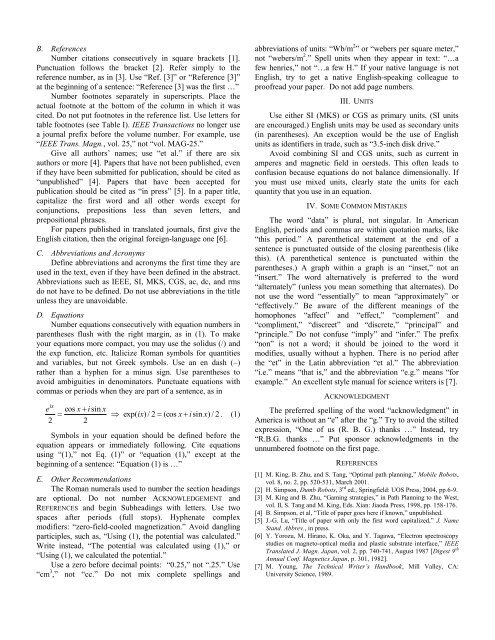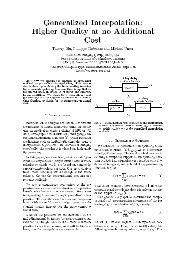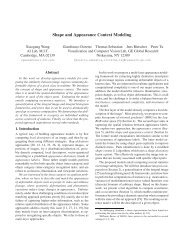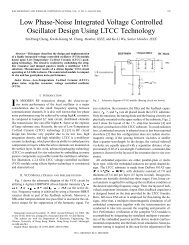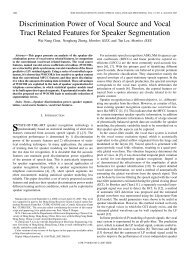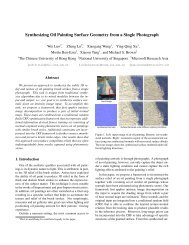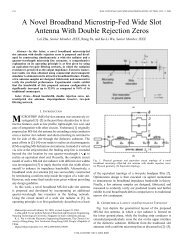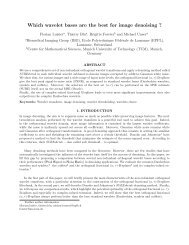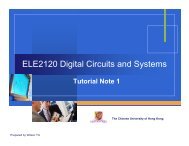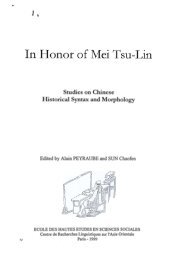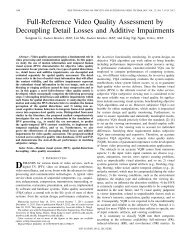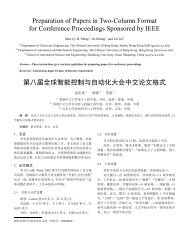IEEE Conference Paper Template - Electronic Engineering
IEEE Conference Paper Template - Electronic Engineering
IEEE Conference Paper Template - Electronic Engineering
You also want an ePaper? Increase the reach of your titles
YUMPU automatically turns print PDFs into web optimized ePapers that Google loves.
B. References<br />
Number citations consecutively in square brackets [1].<br />
Punctuation follows the bracket [2]. Refer simply to the<br />
reference number, as in [3]. Use “Ref. [3]” or “Reference [3]”<br />
at the beginning of a sentence: “Reference [3] was the first …”<br />
Number footnotes separately in superscripts. Place the<br />
actual footnote at the bottom of the column in which it was<br />
cited. Do not put footnotes in the reference list. Use letters for<br />
table footnotes (see Table I). <strong>IEEE</strong> Transactions no longer use<br />
a journal prefix before the volume number. For example, use<br />
“<strong>IEEE</strong> Trans. Magn., vol. 25,” not “vol. MAG-25.”<br />
Give all authors’ names; use “et al.” if there are six<br />
authors or more [4]. <strong>Paper</strong>s that have not been published, even<br />
if they have been submitted for publication, should be cited as<br />
“unpublished” [4]. <strong>Paper</strong>s that have been accepted for<br />
publication should be cited as “in press” [5]. In a paper title,<br />
capitalize the first word and all other words except for<br />
conjunctions, prepositions less than seven letters, and<br />
prepositional phrases.<br />
For papers published in translated journals, first give the<br />
English citation, then the original foreign-language one [6].<br />
C. Abbreviations and Acronyms<br />
Define abbreviations and acronyms the first time they are<br />
used in the text, even if they have been defined in the abstract.<br />
Abbreviations such as <strong>IEEE</strong>, SI, MKS, CGS, ac, dc, and rms<br />
do not have to be defined. Do not use abbreviations in the title<br />
unless they are unavoidable.<br />
D. Equations<br />
Number equations consecutively with equation numbers in<br />
parentheses flush with the right margin, as in (1). To make<br />
your equations more compact, you may use the solidus (/) and<br />
the exp function, etc. Italicize Roman symbols for quantities<br />
and variables, but not Greek symbols. Use an en dash (–)<br />
rather than a hyphen for a minus sign. Use parentheses to<br />
avoid ambiguities in denominators. Punctuate equations with<br />
commas or periods when they are part of a sentence, as in<br />
e ix<br />
cos x isin<br />
x<br />
exp( ix) / 2 (cos x isin<br />
x) / 2 . (1)<br />
2 2<br />
Symbols in your equation should be defined before the<br />
equation appears or immediately following. Cite equations<br />
using “(1),” not Eq. (1)” or “equation (1),” except at the<br />
beginning of a sentence: “Equation (1) is …”<br />
E. Other Recommendations<br />
The Roman numerals used to number the section headings<br />
are optional. Do not number ACKNOWLEDGEMENT and<br />
REFERENCES and begin Subheadings with letters. Use two<br />
spaces after periods (full stops). Hyphenate complex<br />
modifiers: “zero-field-cooled magnetization.” Avoid dangling<br />
participles, such as, “Using (1), the potential was calculated.”<br />
Write instead, “The potential was calculated using (1),” or<br />
“Using (1), we calculated the potential.”<br />
Use a zero before decimal points: “0.25,” not “.25.” Use<br />
“cm 3 ,” not “cc.” Do not mix complete spellings and<br />
abbreviations of units: “Wb/m 2 ” or “webers per square meter,”<br />
not “webers/m 2 .” Spell units when they appear in text: “…a<br />
few henries,” not “…a few H.” If your native language is not<br />
English, try to get a native English-speaking colleague to<br />
proofread your paper. Do not add page numbers.<br />
III. UNITS<br />
Use either SI (MKS) or CGS as primary units. (SI units<br />
are encouraged.) English units may be used as secondary units<br />
(in parentheses). An exception would be the use of English<br />
units as identifiers in trade, such as “3.5-inch disk drive.”<br />
Avoid combining SI and CGS units, such as current in<br />
amperes and magnetic field in oersteds. This often leads to<br />
confusion because equations do not balance dimensionally. If<br />
you must use mixed units, clearly state the units for each<br />
quantity that you use in an equation.<br />
IV. SOME COMMON MISTAKES<br />
The word “data” is plural, not singular. In American<br />
English, periods and commas are within quotation marks, like<br />
“this period.” A parenthetical statement at the end of a<br />
sentence is punctuated outside of the closing parenthesis (like<br />
this). (A parenthetical sentence is punctuated within the<br />
parentheses.) A graph within a graph is an “inset,” not an<br />
“insert.” The word alternatively is preferred to the word<br />
“alternately” (unless you mean something that alternates). Do<br />
not use the word “essentially” to mean “approximately” or<br />
“effectively.” Be aware of the different meanings of the<br />
homophones “affect” and “effect,” “complement” and<br />
“compliment,” “discreet” and “discrete,” “principal” and<br />
“principle.” Do not confuse “imply” and “infer.” The prefix<br />
“non” is not a word; it should be joined to the word it<br />
modifies, usually without a hyphen. There is no period after<br />
the “et” in the Latin abbreviation “et al.” The abbreviation<br />
“i.e.” means “that is,” and the abbreviation “e.g.” means “for<br />
example.” An excellent style manual for science writers is [7].<br />
ACKNOWLEDGMENT<br />
The preferred spelling of the word “acknowledgment” in<br />
America is without an “e” after the “g.” Try to avoid the stilted<br />
expression, “One of us (R. B. G.) thanks …” Instead, try<br />
“R.B.G. thanks …” Put sponsor acknowledgments in the<br />
unnumbered footnote on the first page.<br />
REFERENCES<br />
[1] M. King, B. Zhu, and S. Tang, “Optimal path planning,” Mobile Robots,<br />
vol. 8, no. 2, pp. 520-531, March 2001.<br />
[2] H. Simpson, Dumb Robots, 3 rd ed., Springfield: UOS Press, 2004, pp.6-9.<br />
[3] M. King and B. Zhu, “Gaming strategies,” in Path Planning to the West,<br />
vol. II, S. Tang and M. King, Eds. Xian: Jiaoda Press, 1998, pp. 158-176.<br />
[4] B. Simpson, et al, “Title of paper goes here if known,” unpublished.<br />
[5] J.-G. Lu, “Title of paper with only the first word capitalized,” J. Name<br />
Stand. Abbrev., in press.<br />
[6] Y. Yorozu, M. Hirano, K. Oka, and Y. Tagawa, “Electron spectroscopy<br />
studies on magneto-optical media and plastic substrate interface,” <strong>IEEE</strong><br />
Translated J. Magn. Japan, vol. 2, pp. 740-741, August 1987 [Digest 9 th<br />
Annual Conf. Magnetics Japan, p. 301, 1982].<br />
[7] M. Young, The Technical Writer’s Handbook, Mill Valley, CA:<br />
University Science, 1989.


